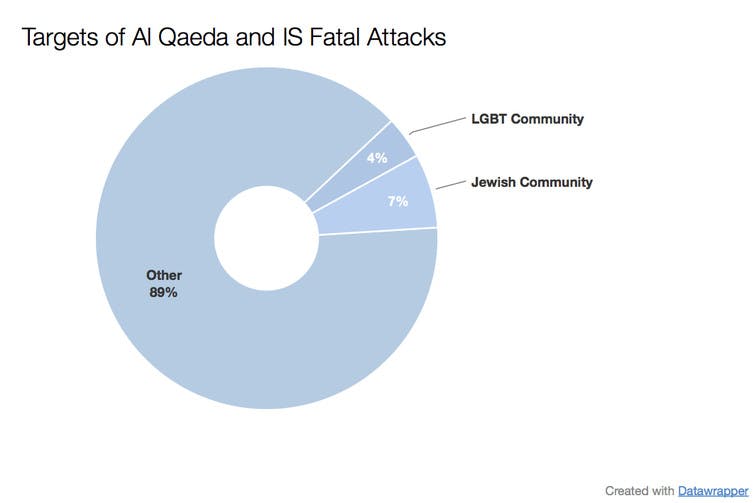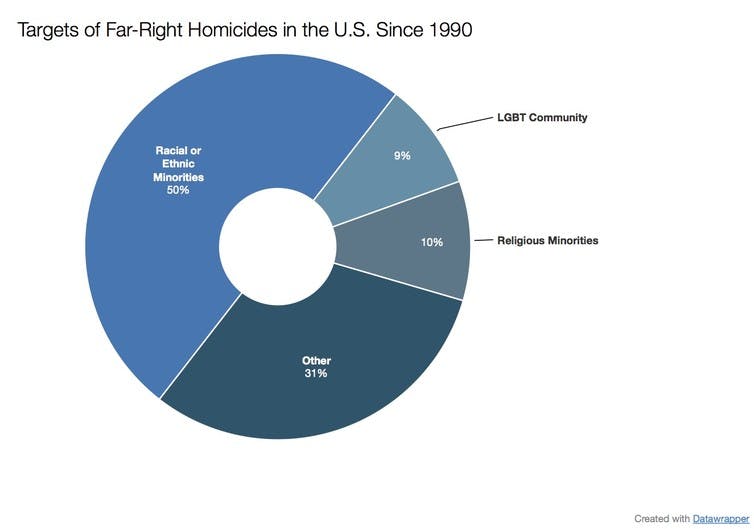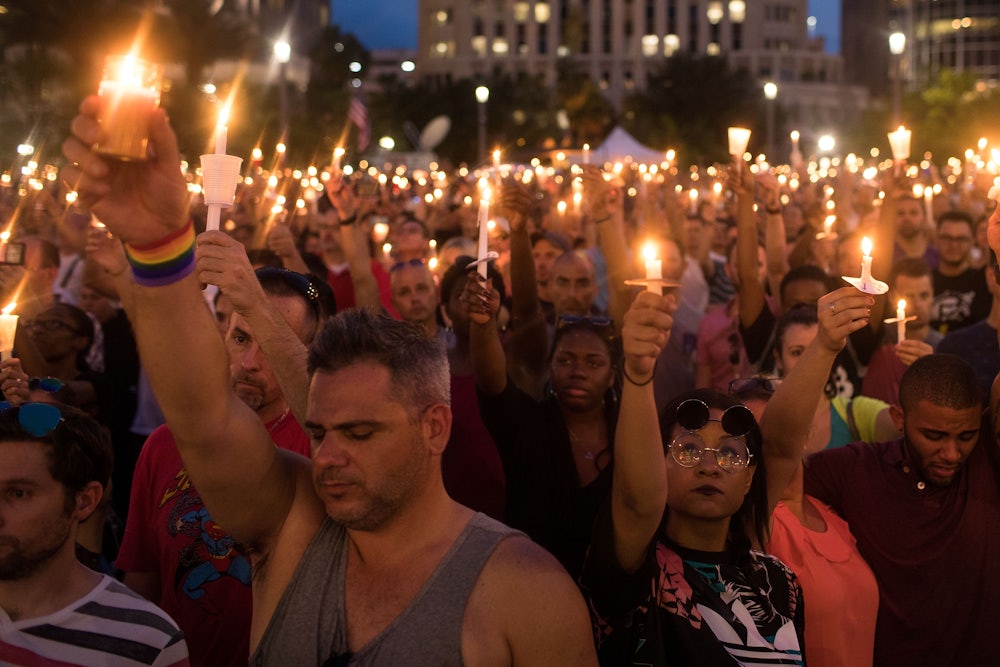Some are calling the mass shooting at an Orlando gay nightclub an act of terrorism. Others are calling it a hate crime against the LGBT community. President Obama declared it an “act of terror and an act of hate.”
Can it be both?
It’s an important question. How extremist crimes are labeled by officials directly affects how offenders are charged, their likelihood of being convicted and the severity of their sentences.
Labels are also symbolic acknowledgments by the government of the harms inflicted on the nation by terrorists, and on specific social groups by hate crimes. These labels can shape how the public thinks about extremist crimes.
We have been researching terrorism, extremism and hate for more than 15 years and currently direct the United States Extremist Crime Database (ECDB) study.
A tool for fighting violence
The ECDB is a database of more than 2,500 extremist perpetrators. All committed a crime and supported either extreme far-right, ecoterrorism or jihadist ideologies. Since 1990, these extremists have been responsible for more than 1,000 ideologically motivated homicides, foiled plots, arsons or bombings in the U.S.
The ECDB includes incidents that may be defined as both terrorism and hate crimes. The database includes comprehensive information about each offender’s demographic background, extremist and criminal histories, mental health statuses, personal achievements and setbacks.
As such, the ECDB is a resource for studying crimes committed both by extremists affiliated with terrorist and/or hate organizations and lone wolves. Databases such as the ECDB allow researchers to explore how and when terrorism overlaps with hate, and give us a better understanding of what drives extremists to commit violent acts.
Hate crime or terrorist act?
A hate crime is any criminal offense, like murder, assault or vandalism, with the added element of bias. The act is considered a hate crime even if a perpetrator acts on a variety of motives, so long as bias played a part: for example, if an offender is motivated by both greed and prejudice toward the victim because of his or her race, gender, sexual orientation or other characteristic.
While there are many definitions of terrorism, almost all classify terrorism as a violent crime committed for political or ideological reasons. Nonviolent or violent offenses committed for personal motivations, like greed, are not considered terrorism.
Many hate crimes in the U.S. are not terrorist acts because they lack a violent or extremist component. Tagging property with graffiti would be an example. Hate crimes are often property offenses. They are typically committed by nonpolitical youths who do not seek to further any ideology. Rather, they commit the hate offense for the thrill of it.
In turn, terrorist acts in the U.S. are often not hate crimes. Indeed, many violent, ideologically motivated attacks in the U.S. don’t target a specific race or religion. Instead, they are aimed at the U.S. government, random civilians, American society at large, or entities like research laboratories or food production plants that some believe harm animals or the environment. The 9/11 attacks are an example.
Overlap is possible
A few attacks are both terrorist acts and hate crimes. The mass shooting by Omar Mateen that occurred at the Pulse nightclub in Orlando is one such example.
These attacks are violent and are committed by far rightists, al-Qaida or Islamic State (IS) supporters to further their extremist ideology. That makes them terrorism.
These attacks also purposefully target racial, sexual orientation or religious minorities, and so are hate crimes too.

Of the 196 far-right extremist homicides we identified, 50 percent targeted racial or ethnic minorities, nine percent were hate crimes against the LGBT community and around 10 percent targeted religious minorities.

Of the 44 al-Qaida and IS homicides we identified, seven percent targeted the Jewish community while another four percent targeted the LGBT community.
A notable number of these fatal attacks, by both the far-right and al-Qaida extremists, would be classified as both terrorist acts and hate crimes by many definitions.
On the other hand, more than 85 percent of the al-Qaida and IS deadly attacks, and over 30 percent of the far-right fatal attacks, would be classified as terrorism only.

The number of ideologically motivated hate crimes and terrorism homicides have trended differently over time.
Through the 1990s, the number of hate crimes remained relatively stable, then declined through 2004.
In contrast, the number of terrorism homicides rose gradually and consistently between 1990 and 2004, then declined until 2009. There has been a slight increase since then.
Security through understanding
This week’s murders serve as a reminder of the significant threat posed by domestic extremists in the U.S.
Over the last 20 years, an impressive amount of research has been published on the motivations of perpetrators, and characteristics of events and targets. The Orlando tragedy, and the data presented here, demonstrate the importance of exploring difficult questions.
For example, are terrorists who commit acts of hate and terrorists who target the government radicalized the same way?
Are perpetrators motivated by far-right extremist views similar to those motivated by jihadist extremism?
What factors helped push these perpetrators to violence, and what steps can be taken to stop it from occurring again?
Answering these questions may help law enforcement identify, investigate, prosecute and ideally thwart those who seek to turn to violence to achieve their goals.
The views and conclusions contained in this article are those of the authors and should not be interpreted as necessarily representing the official policies, either expressed or implied, of the U.S. Department of Homeland Security, or START.
![]()
This article was originally published on The Conversation. Read the original article.
